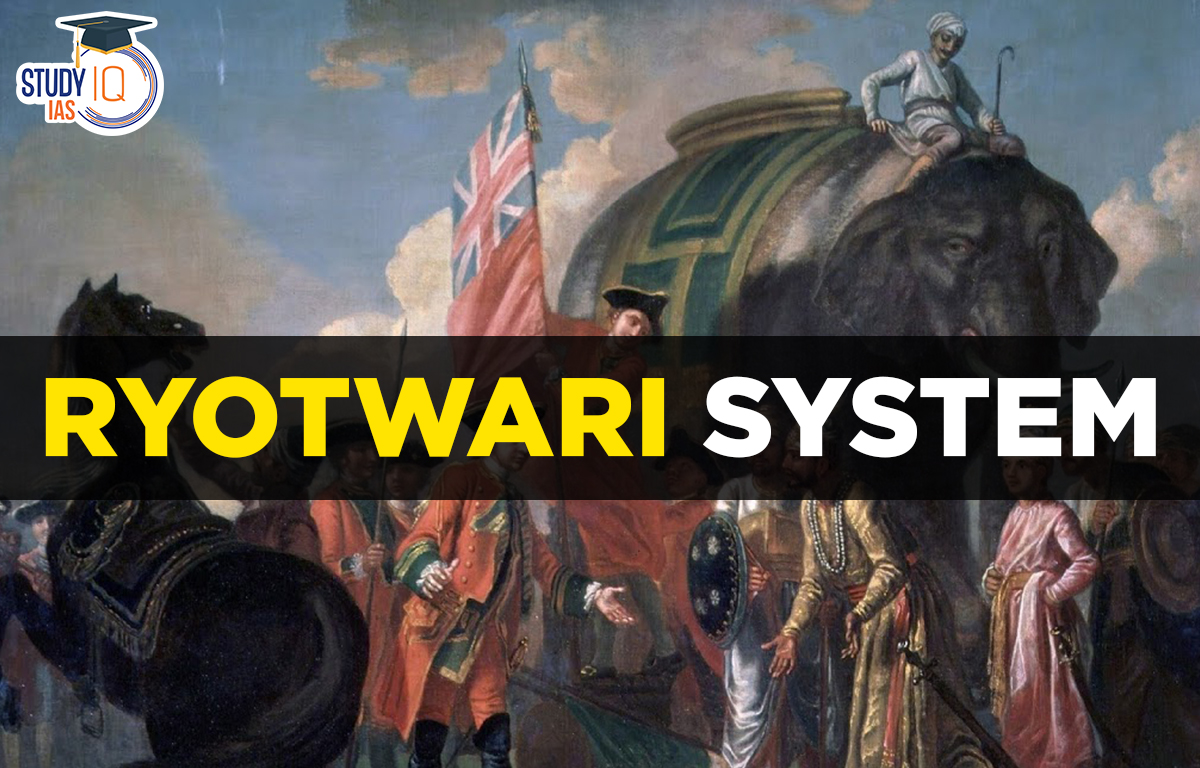Table of Contents
The Ryotwari System was one of the three principal land revenue systems adopted by the British East India Company in India during the colonial era. While the Zamindari system involved landlords as middlemen, the Ryotwari system was designed to create direct settlement between the government and the individual cultivator or peasant, referred to as the ‘ryot’ (or ‘raiyat’).
Ryotwari System
A land revenue system known as the Ryotwari System was first implemented in British India’s southern region to replace Permanent Settlement. Thomas Munro introduced the Ryotwari System of Land Revenue, which made it possible to collect money from farmers. The Ryotwari settlement gave the government the ability to receive direct payments from cultivators, also known as “ryot.” To get ready for the UPSC IAS Prelims and Mains tests, candidates might read additional NCERT Notes on the History of Modern India.
In the latter part of the 18th century, Ryotwari Settlement was established, and the system allowed peasants to have authority over their holdings. Learn more about the origins and characteristics of the Ryotwari System.
What is the Ryotwari System?
Captain Alexander Read and Sir Thomas Munro developed the Ryotwari System, a land revenue system. While serving as the Madras Presidency’s governor from 1819 to 1826, Munro brought the ryotwari settlement to Tamil Nadu. For the purpose of collecting taxes, the government could interact directly with the farmer (‘ryot’), and the peasant might sell or buy more land for farming.
Ryotwari System of Land Revenue
Sir Thomas Munro, the Governor of Madras, created the Ryotwari System of Land Revenue in 1820. Captain Reed implemented this technique for the first time in the Baramahal region of Tamil Nadu under the Madras presidency in 1792.
It was first introduced in the regions of Assam and Coorg, as well as Madras and Bombay. The cultivator or peasant is the Ryot or owner of the land in this system of land revenue, and they retain full ownership rights, including the ability to sell, mortgage, or gift land to anyone as compensation. They may do whatever they want with the land.
Features of Ryotwari System
He brought techniques for the farmers in the provinces of Madras, Bombay, Assam, and Coorg to practice. In the Ryotwari System, the land was supposed to belong to cultivators or farmers, who would then have unrestricted access to it. Each of the cultivators was given full ownership of the overall land area. The land might be purchased, sold, mortgaged, or even gifted by them to anyone.
The government imposed taxes on the land, which the peasants were required to pay, according to a statement made by Sir Thomas Munro. The Ryotwari System rates were also determined by the type of land, with dry land having a rate of 50% and wetland having a rate of 10% and 60%, respectively.
These rates may vary, usually rising with time, and they were only transitory, i.e., there was no permanence in the rates of the land taxes. Any peasant or cultivator who failed to pay their taxes on time due to the ambiguity in the land tax grading system would be kicked from their land by the government.
Although a middleman is a concept in the zamindari system, there was none in the Ryotwari System. The British government did not accept any form of payment for the extremely high taxes, hence cash payments were required. Consequently, another issue the farmers encountered was the exorbitant interest rates charged by the money lenders.
Ryotwari System in India
The name “ryot” refers to peasant cultivators. Sir Thomas Munro first proposed the Ryotwari System, a concept for collecting land rent from farmers, in 1820. He was a British soldier who previously served as Madras’ governor. He made more than half of the British Indian farmers pay these charges.
Ryotwari System in Madras
The Ryotwari System was first introduced in 1820 when Sir Thomas Munro was the governor of Madras state or province.
The British believed that the Ryotwari System should not involve any middlemen and that they could obtain the majority of the revenue straight from the cultivators by implementing this form of land revenue collecting mechanism.
The Madras government was chronically underfunded, therefore this sort of income collection made logical sense. This was another major justification for its introduction. This notion was put forth to the British Parliament by the Madras government. But it was rejected; therefore the temporary Ryotwari Settlement was put into effect.
Ryotwari System in Bombay
Gujarat was the original location of the Ryotwari System of Bombay. The British government used to collect taxes from the “desias,” who were the hereditary officers and the village headman, prior to the introduction of the Ryotwari System.
They brought the Ryotwari System and began obtaining the land tax from the growers because this collection was insufficient for them. Later, in 1818, following their conquest of the Peshwa domain in Bombay, they instituted the Ryotwari System.
Elphinstone, a follower of Munro, was in charge of such a system in Bombay. In Bombay, where the peasants were obliged to give the tax and the government kept gradually raising the rates rapidly, a similar system of revenue collection was formed.
Drawbacks of Ryotwari Land Revenue System
One significant downside of this arrangement was the high rates of tax collection from the cultivator. This is due to the fact that the rates set for land taxes were disproportionately greater than the real capability for land production. The British government’s collection procedure for the review was highly arrogant and strict.
The British government would torment the peasants and evict them if the cultivator was unable to pay the required amount at the time. This system’s officers could be easily bought off when appraising the land, which was another significant flaw. As a result, bribery rose to a high degree. Increased taxes on the lands reduced their worth because they weren’t properly maintained. Farmers’ inability to care for their land is the cause of this.
| Related Articles | |
| Land Reforms in India | Mahalwari System |
| Doctrine of Lapse | Subsidiary Alliance System |
| Dandi March | Partition of Bengal |
| Battle of Buxar |
Battle of Plassey |


 Revival of Machilipatnam Port in Andhra ...
Revival of Machilipatnam Port in Andhra ...
 Nagari Pracharini Sabha Revival: Backgro...
Nagari Pracharini Sabha Revival: Backgro...
 Battle of Plassey, History, Causes, Impa...
Battle of Plassey, History, Causes, Impa...





















